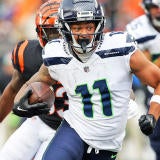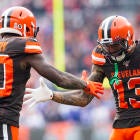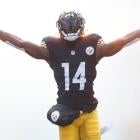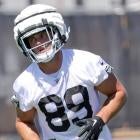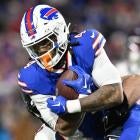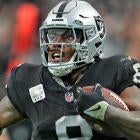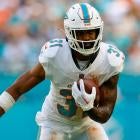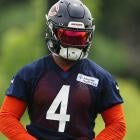As we approach the holidays and time gets a little thinner, we'll be doing something a bit different with Stealing Signals. Through the remainder of the season, I'll be replacing the main portion of each game's writeup with quicker-hitting bullet points of trends and other notes.
The snaps, key stat, signal and noise will remain. For those of you diligently reading each week, this will hopefully be a bit easier to consume as we approach the home stretch and the bye weeks end. For those of you just skimming, this should be easier for you, too!
Also, keep an eye out after the season, when I'll be recapping the trends in a seasonal wrap for each team in January. I'll be striving to give you Dynasty players plenty to consider for the offseason and provide a reference point for next summer when Redraft season ramps back up. Hope you enjoy the new format!
Data is typically courtesy of Pro Football Reference, RotoViz, the RotoGrinders Premium Usage App, airyards.com or PFF. Always feel free to hit me up on Twitter @YardsPerGretch with any questions about anything I covered or to ask my thoughts on something I glossed over. That is some of my favorite feedback, because sometimes it's something I've missed.
Here are some important statistical acronyms to know for Stealing Signals:
Green Zone - Inside the opponent's 10-yard line.
HVT - High-Value Touches: for running backs, all receptions and all touches inside the 10 yard line.
TRAP - Trivial Rush Attempt Percentage: for running backs, the percentage of all touches that are not high-value touches.
WOPR - Weighted Opportunity Rating: a metric created by Josh Hermsmeyer, it balances team share of targets and team share of air yards. Because a player's WOPR is a share of his team's overall opportunity, it's important to consider team volume as additional context.
RACR - Receiver Air Conversion Ratio: also created by Hermsmeyer, RACR is calculated as total receiving yards divided by total air yards. Similar to yards per reception or yards per target, but per air yard instead.
Week 12
Texans 20 - Colts 17
Snap notes: Will Fuller: 90% (return from hamstring injury), Kenny Stills: 63% (-22 vs. four-game low when Fuller was hurt), Jonathan Williams: 67% (+23 vs. Week 11 season high), Nyheim Hines: 33% (+4 vs. season average), Jordan Wilkins: 1% (-12 vs. season average), Zach Pascal: 88% (lowest since Week 7), Marcus Johnson: 63% (lowest since Week 10 season debut), T.Y. Hilton: 37% (-46 vs. season average)
Key stat: Will Fuller — 90% snap share, 11 targets, 164 air yards
- Will Fuller was fantastic in his return, going 7-140 on 11 targets and 164 air yards to easily lead the game in receiving opportunity. DeAndre Hopkins' 6-94-2 came on great volume as well — eight targets and 114 air yards — and both Texans receivers made multiple electric plays as the passing game was very concentrated between those two. The rest of the team combined for just nine targets.
- Darren Fells and Jordan Akins still had roles, but Akins' presence limited Fells as usual. Texans tight end Jordan Thomas also made his season debut, playing seven snaps. Thomas caught four touchdowns in his 2018 rookie season and could grow into a role that further dilutes Texans tight end targets.
- Jordan Wilkins returned for the Colts but played just one snap, as Jonathan Williams got the feature back treatment and Nyheim Hines' role was unchanged.
Colts gave Jonathan Williams better usage last night than Marlon Mack has gotten all season:
— Adam Levitan (@adamlevitan) November 22, 2019
* 67% of the snaps
* Ran 17 routes on 29 Brissett dropbacks
* Handled 26 carries plus 3 targets
- The Colts ran 39 times against just 25 pass attempts. We always talk about how game script sensitive they are, but they leaned heavily toward the run despite neutral script in this one. There was a lot of commentary on Twitter about how efficient they were on the ground — and they were, averaging 4.5 yards per rush — and yet runs are inherently more conservative than passes. There's really no better argument for throwing more than running than looking at the Colts being so effective on the ground yet being out-gained by 100 yards, scoring just 17 points and losing.
- T.Y. Hilton returned to a limited role, but still led the Colts in targets and air yards. Marcus Johnson gave up more snaps than Zach Pascal to accommodate Hilton, and Pascal's full-time role notably began before Hilton's injury. Hilton should be ready for more playing time in Week 13 after 10 days off, and I'd expect Pascal to play a solid number of snaps as the No. 2 when Hilton's back to full strength.
Signal: Jonathan Williams — heavy usage as lead back; Will Fuller — healthy, played full snap share, tons of opportunity led to concentrated Texans pass attack
Noise: T.Y. Hilton — 6 targets, 18 yards (played limited snaps, still led team, should be clear No. 1 going forward)
Buccaneers 35 - Falcons 22
Snap notes: Ronald Jones: 50% (-5 vs. season high), Peyton Barber: 23% (-8 vs. season average), Dare Ogunbowale: 21% (-2 vs. previous season low), O.J. Howard: 77% (+53 vs. Week 11), Brian Hill: 59% (-1 vs. Week 11 season high), Qadree Ollison: 26% (+8 vs. Week 11 season high), Julio Jones: 56% (banged up, did return), Jaeden Graham: 66% (+14 vs. Week 11 season high)
Key stat: Calvin Ridley — 14 targets, 189 air yards
- The Bucs had plus script throughout, so it was good news for Ronald Jones, who had multiple strong runs to post a 12-51-1 line — converting his only green zone touch for a 4-yard score to remain highly efficient in close — and caught all three targets he saw. Unfortunately, this appears to be Jones' touch ceiling, as Peyton Barber got some late work, rushing 11 times for 32 yards to salt the game away. Earlier, T.J. Logan got a green zone rush from the 3 as the Bucs hurried to the line after a long completion, then Barber subbed in for what turned into a 1-yard touchdown pass to defensive tackle Vita Vea. So Jones continued to give up snaps in the green zone, didn't get to rack up carries to salt away a win, and we know Dare Ogunbowale plays in negative scripts. It's great to see Jones produce, and he did have four high-value touches, but this was a game script where he could have had a much higher ceiling. As a truther, I still hate his usage.
- Chris Godwin was the big story in the passing game, catching a 71-yard touchdown in the first quarter and adding a 1-yard touchdown in the second. Godwin had his first 100-yard game in over a month, posting a huge 8-7-184-2 line. Mike Evans took a bit of a back seat, and we've seen these two trade off production a bit, though Evans still saw eight targets and 87 air yards, catching four for 50.
- Other than Godwin, Evans and Jones, no other Buc was targeted more than twice, though that man was O.J. Howard. Howard's snaps dipped all the way down to 24% in Week 11 after an early drop became an interception, but they rebounded back up to 77% in Week 12. Didn't lead to any change with his targets, unfortunately.
- In a week bereft of offense, Atlanta stood out, running 80 plays and throwing 55 passes in catch-up mode. Julio Jones got a little banged up and was in and out of the lineup in the second half, running routes on just 52% of dropbacks. He still saw nine targets, finishing with a 5-68 line.
- Calvin Ridley, Russell Gage and fourth-string receiver Russell Blake stepped up in Jones' absence. Ridley led the team with 14 targets and 189 air yards, a season high for him, but caught just six balls for 85 yards and a late score from Matt Schaub after Ryan had been removed for the final drive. Gage's routes bounced back to 82% of dropbacks and he went 10-8-76 in Mohamed Sanu's old role. Blake caught just two of the nine passes he saw in place of Jones, four of which came from Schaub.
- Brian Hill was again the lead back, but Qadree Ollison stole all three green zone touches as the bigger back has solidified himself as the go-to guy in close. Ollison got three consecutive carries from the 5, 1 and 1 again in the first quarter, finally punching in the 1-yard score. That puts a cap on Hill's usability given Atlanta is fine abandoning the run and he isn't much of a pass catcher. He did have three receptions on four targets, but wound up with just 27 total yards on 12 total touches.
Signal: Qadree Ollison — appears to be the goal-line back; Ronald Jones — still good, still dealing with frustrating usage; O.J. Howard — played a full snap share
Noise: Julio Jones — lack of targets, production (was injured, ran routes on just 52% of dropbacks)
Seahawks 17 - Eagles 9
Snap notes: Chris Carson: 54% (lowest since Week 3), Rashaad Penny: 46% (+14 vs. previous season high), Tyler Lockett: 86% (was questionable), Josh Gordon: 34% (-3 vs. Week 10 SEA debut), Jordan Matthews: 96% (+10 vs. Week 11 PHI debut), JJ Arcega-Whiteside: 71% (+41 vs. season average), Greg Ward: 49% (+46 vs. previous season high), Miles Sanders: 84% (-1 vs. Week 11 season high), Jay Ajayi: 12% (debut)
Key stat: Rashaad Penny — 1 high-value touch (14 total touches), Chris Carson — 5 HVT (12 touches)
- Rashaad Penny had a breakout game with a 14-129-1 rushing line. Coming out of the Week 11 bye, Penny seemed to be working in more even before Chris Carson fumbled on back-to-back plays (the second was charged to Russell Wilson on a failed handoff) early in the fourth quarter. Carson now has seven recorded fumbles on the season plus two more on botched handoffs (Week 2, Week 12) that were registered to Wilson but were by my estimation more on Carson. Still, Seattle has been hesitant to move away from him. Despite Penny's 14-to-8 edge in rush attempts, Carson still played more snaps and was notably much more active in the pass game than Penny (four targets to one, twice as many routes run). Carson caught one of his four passes on the second play of the drive immediately following his two fumbles, so it's not like he was benched, though Penny handled all five of the rush attempts from that point on. Each had one green zone touch, though that was Penny's only high-value touch. Penny has earned more work, and how it splits out next week is up in the air, but the best guess is Carson will be involved and see more high-value touches.
- Josh Gordon's role did not expand after the bye as Malik Turner — who caught a long touchdown on a flea flicker — and David Moore continued to rotate in and Tyler Lockett and D.K. Metcalf played full shares. Other than the top two pass catchers, Jacob Hollister (69%) was the only other Seahawk to run routes on more than 50% of dropbacks. Hollister should have had a touchdown in the second quarter but Wilson sailed an easy throw over his head out of bounds, forcing Seattle to settle for a field goal.
- In the plus script, Seattle went run-heavy late, finishing with 26 rushes against just 25 pass attempts. The targets were evenly distributed with D.K. Metcalf leading the team with six targets and 107 air yards. After failing to haul in some catchable balls in the overtime win in Santa Clara, Metcalf had a few more suspect plays in Week 12, but he, Lockett and Hollister are the only startable options in the passing game for the time being.
- Without any of their top three wide receivers coming into the season, the Eagles continued their heavy two-TE sets with both Zach Ertz and Dallas Goedert playing 87% snap shares. Jordan Matthews and J.J. Arcega-Whiteside led the receivers in playing time, but the Eagles offense struggled throughout. Carson Wentz completed 12 of his final 13 passes against prevent defenses, including underneath completions to Zach Ertz on four consecutive plays at one point, plus a touchdown pass to Ertz with 22 seconds left. Ertz finished 14-12-91-1 to easily lead the Eagles in all receiving categories.
- Jay Ajayi rushed six times for 16 yards, but played just nine snaps overall in a purely backup role. Miles Sanders played another huge snap share, caught three of five targets and was much more efficient on the ground than Week 11, racking up 63 yards on 12 carries. Jordan Howard's status will need to be monitored, but Sanders took a step forward despite the offense — which has scored a total of 19 points the past two weeks — holding his production back a bit by struggling to sustain drives and turning the ball over five times.
Signal: Rashaad Penny — more involved out of bye; Chris Carson — still lead on pass downs
Noise: Eagles receiving corps — picked up a ton of garbage time receptions; Jacob Hollister — down game (low pass volume, still ran plenty of routes, should have had a TD)
Browns 41 - Dolphins 24
Snap notes: Nick Chubb: 57% (-3 vs. previous season low), Kareem Hunt: 57% (+2 vs. season average), Mike Gesicki: 90% (+4 vs. Week 11 season high), Kalen Ballage: 38% (-39 vs. Week 11), Patrick Laird: 37% (+14 vs. Week 11 season high), Myles Gaskin: 25% (+15 vs. Week 11 season high)
Key stat: Nick Chubb — 12 green zone touches in three games with Kareem Hunt (leads NFL by 3)
- The Browns continue to be what they showed us in Kareem Hunt's Week 11 debut. After that game I noted, "The two backs played together frequently" and "the way Hunt was incorporated was a very positive outcome for Chubb's value, who didn't lose much work in the backfield and was still involved in the passing game." I added, "I'm not sure we'll see this type of usage from these two every week, but it would make a lot of sense. If we do, both will be very viable Fantasy options." The two-back sets have tapered off a bit, and Chubb played a season-low snap share in the Week 12 blowout, though his routes bounced back. But the touches in the offense remain highly concentrated between the backs and the two star receivers.
- Since the offensive change, the Browns are 3-0 and are averaging the 10th-most yards per play in that span. They certainly padded their offensive numbers in the win against Miami, but the other two games were against Buffalo and Pittsburgh, both tough matchups (their defenses rank third and seventh in yards per play allowed). We have to be optimistic about their potential going forward, especially in Weeks 14 and 15 given matchups with the Bengals and Cardinals.
- Expanding on the concentration a bit, no Brown outside of Chubb, Hunt, Odell Beckham or Jarvis Landry has seen more than two targets (or rush attempts) in any of the past three games. Landry led the way in the passing game in Week 12 with a monster 13-10-148-2 line against his former team, while Beckham went 8-6-84-1. Chubb's targets bounced back from a down Week 11, and he out-targeted Hunt, though Hunt got a rushing TD. Chubb also scored on the ground, and the offensive improvement has been a bigger positive for him than Hunt's presence, as Chubb leads the NFL in green zone touches over the past three weeks with 12. All four players are solid Fantasy options going forward, though David Njoku's eventual return could mean a little less concentration of targets.
- Ryan Fitzpatrick continues to throw the ball around — even, and perhaps especially, when they are down by several scores — and DeVante Parker continues to be his top target. Parker went 11-6-91 with 119 air yards, while each of Allen Hurns, Mike Gesicki and Albert Wilson had seven targets. Wilson's running routes on about half of Fitzpatrick's dropbacks, while Gesicki and Hurns have both been over 85% each of the past two weeks. Gesicki saw 77 air yards, his second most on the season, and is a viable tight end streamer.
- Kalen Ballage has been very bad on a per-touch basis and his snap share reflected that, as it was halved in Week 12. Patrick Laird and Myles Gaskin both worked in, which made it a three-way committee. Laird led in routes run with 14, while Ballage had 12 and Gaskin six. That makes it challenging to play any of these guys, but Ballage in particular shouldn't be in lineups given he no longer has the lion's share of the touches.
Signal: Mike Gesicki — routes have trended up, air yards followed this week, viable TE streamer; Kalen Ballage — no longer a heavy snap share, now in a three-way committee
Noise: Nick Chubb — season low snap share (he didn't sub out early with the big lead, but he did still get 24 touches so I'm not reading too much into the snaps dipping)
Bears 19 - Giants 14
Snap notes: Taylor Gabriel: 55% (-36 vs. Week 11), Anthony Miller: 55% (-31 vs. Week 11), Tarik Cohen: 55% (third straight game in the fifties after season lows in Weeks 8 and 9), Saquon Barkley: 97% (+9 vs. previous season high), Sterling Shepard: 95% (first game since Week 5), Kaden Smith: 98% (+41 vs. Week 10 season high)
Key stat: Daniel Jones — 150 passing yards on 36 attempts (4.2 YPA)
- Chicago's snaps and routes are all over the place week to week, seemingly dependent on matchup and script. David Montgomery's snaps were up in this one, though Tarik Cohen's weren't down. After both Taylor Gabriel and Anthony Miller were highly utilized in Week 11 with Allen Robinson tied up with Jalen Ramsey, the secondary receivers both gave up a ton of snaps this week for increased usage of both two-back and two-TE sets. That wasn't all script-related, though, as the Bears still threw 41 times against 26 rushes in the win. There's probably a positive note here that the Bears are at least trying different things to fix their broken offense.
- David Montgomery continues to struggle, and is now averaging just 3.3 yards per carry for the season. He ran a few more routes this week but had just 9 receiving yards on two catches and three targets. He did have two carries from the 3-yard line but wasn't able to score. Meanwhile, Tarik Cohen continues to get featured, and while the Bears are incorporating both backs simultaneously similarly to the Browns, they aren't finding the success Cleveland is. Cohen is probably the better option in PPR for the time being given his receiving role, but neither is a great option.
- Allen Robinson found a way to overcome bad quarterback play and post a 10-6-131-1 line despite a 60-yard play being negated by a hands to the face penalty at the line. He got wide open on his touchdown and was able to slow down to catch a late pass from Mitchell Trubisky. He remains the clear No. 1 but will be inconsistent as he deals with subpar quarterback play.
- Anthony Miller went for 9-6-77 as the main other downfield option, but he dipped from 47 routes in Week 11 (92% of dropbacks) to just 27 in Week 12 (59%). He now has 20 targets over the past two games but that volume feels far from secure given his role bounces around and guys like Gabriel and Cohen can also be heavily involved.
- Saquon Barkley played a season-high 97% snap share but struggled to find room again in a tough matchup. What I said after the Giants' last game still applies: "He's still electric and will surely break big plays the rest of the way, but we have a pretty big sample now that says he needs those big plays to have RB1 value, and that's not ideal. For most elite backs, the big plays take their performances up a notch — see Christian McCaffrey's 40-point games — but they can rely on a consistent level of production even without them. Saquon doesn't have that solid double-digit floor right now, even despite strong reception totals most weeks."
- Sterling Shepard played big snaps but totaled just 15 receiving yards on nine targets and five receptions. Shepard did add 22 rushing yards, but Daniel Jones had trouble getting the ball down the field to anyone against Chicago, averaging just 4.2 yards per attempt (150 passing yards on 36 passes). Darius Slayton and Golden Tate were more effective with their seven targets each, with fill-in tight end Kaden Smith went 6-5-17-1. What's clear is we'll see a lot of 11 personnel with these three main receivers and whichever tight end is healthy, plus Barkley, as the main offensive configuration. What's less clear is whether the suddenly crowded receiving corps can provide any value in a bad offense.
Signal: Saquon Barkley/Sterling Shepard — both played huge snap shares, seemed healthy
Noise: Sterling Shepard — 1.7 yards per target (9 targets, big snaps were good signs); Anthony Miller — I'm not buying the 20 targets over the past two weeks when the routes dipped, but there's certainly room for a more modest role
Saints 34 - Panthers 31
Snap notes: Both teams remain highly concentrated
Key stat: Alvin Kamara — 29 HVT over past three weeks (second in NFL to Christian McCaffrey)
- Since the Saints got healthy out of the bye, routes have been very concentrated over the past three games, with Michael Thomas at or near 100% of dropbacks, each of Tre'Quan Smith, Ted Ginn and Jared Cook in the 75% range, and Alvin Kamara at 70%, with Latavius Murray mixing in for some RB routes. But despite Smith scoring a touchdown in Week 12 and Ginn setting a season high with 160 air yards as Drew Brees pushed the ball downfield more, the targets are still even more concentrated around Thomas and Kamara, with Cook looking like the third option.
- Cook also set a season high in air yards with 107, as well as a season high in receiving yards with an 8-6-99-1 line.
- There seems to be some concern about Kamara, but his 29 high-value touches since returning from injury are second most in the NFL in that span. Latavius Murray's 26-yard touchdown run plus a couple of longer touchdown throws meant the Saints ran just one play in the green zone, a short touchdown pass to Michael Thomas. That play was set up by a 30-yard run from Kamara down to the 3-yard line. Kamara had four green zone touches to Murray's two over Weeks 10 and 11, and the touchdowns should come for Kamara — who has just two on the year and hasn't scored since Week 3 — when the Saints run some plays in close. We know the receiving work is there.
- The only RB with more HVT than Kamara over the past three weeks is of course Christian McCaffrey, whose six green zone touches in Week 12 were a season high. McCaffrey is now second in the league in green zone touches to Dalvin Cook, emphasizing his huge scoring potential on top of his massive receiving role.
- D.J. Moore's touchdown regression hit, and the first one was notable in that it was all air yards, a 51-yard bomb where Moore showed he has more in his game than just low-aDOT possession-type receptions. Moore, of course, is also very good with the ball in his hands, and later added a 52-yard reception that was mostly yards after the catch. He also caught a second touchdown from just 2 yards out, checking off a "concern area" box by converting in close. I've been yapping about him being elite since the offseason so I'll spare you the superlatives, but he's very much the real deal.
- There's nothing particularly wrong with Curtis Samuel or Greg Olsen — Moore's ascension has just rapidly transformed the Carolina offense into something resembling New Orleans', centered around a touch-dominant dual-threat back and a target hog No. 1 receiver.
Signal: D.J. Moore — capable of scoring touchdowns; Jared Cook — role remains strong, looks like clear third offensive option (which is the best you can hope for in New Orleans)
Noise: Alvin Kamara — no touchdowns since Week 3
Bills 20 - Broncos 3
Snap notes: Dawson Knox: 78% (+2 vs. previous season high), Royce Freeman: 56% (+27 vs. Week 11), Phillip Lindsay: 54% (-11 vs. Week 11)
Key stat: Broncos — 134 total yards (46 offensive plays)
- This game wasn't nearly as close as a 20-3 scoreline might indicate. The Bills out-gained the Broncos 424 to 134, and Josh Allen only had to throw 25 times before they turned to a run-heavy attack. They rushed 47 times overall for 244 yards on the ground, with Devin Singletary leading the way at 21-106 and Frank Gore going 15-65.
- Chris Harris appeared to be shadowing John Brown, lining up across from him on both sides of the field. Harris mostly held Brown in check while Cole Beasley stepped up to the tune of a 9-6-76-1 day, then Brown did beat Harris with a double-move late to get on the board with a 34-yard touchdown that brought his final line to 4-2-39-1. No other Bills pass-catcher had more than 25 receiving yards.
- Brandon Allen completed 10 of 25 passes for 82 passing yards, and also took four sacks for a total of 33 yards lost. It was never a great matchup for Courtland Sutton on Tre'Davious White, and he did haul in a 27-yard catch, but the other seven passes thrown his way for 112 total air yards went incomplete. Sutton's 1.01 WOPR was tops in Week 12, meaning he continues to dominate the targets and air yards for Denver, but he's another receiver being held back by subpar quarterback play.
- Noah Fant went 5-3-14 and is a tough Fantasy option. He's been the clear second weapon in the passing game but this passing game doesn't appear capable of supporting even Sutton every week. Drew Lock should take over at some point and will hopefully improve things, but that's not a certainty.
- Phillip Lindsay was again the lead back, though Royce Freeman gained some snaps back on passing downs. This situation continues to be far less appealing without all the receiving work Joe Flacco generated for them. Lindsay had the huge touch lead 14 to four, but they only had three high-value touches between them, and Freeman had two of them. I wouldn't cut Lindsay, but I'd certainly rather have him on my bench given there's not much scoring potential or receiving work in the offense. He's an efficient runner, but 13 low-value rush attempts like he had this week aren't going to get the job done.
Signal: Phillip Lindsay — had a more clear No. 1 role in Week 11, but Freeman took back passing down reps in Week 12
Noise: Bills — they're happy to run, but a 25/47 pass/run ratio is extreme; Broncos — 49 net passing yards is unsustainably bad
Washington 19 - Lions 16
Snap notes: Derrius Guice: 43% (+12 vs. Week 11), Adrian Peterson: 33% (+7 vs. Week 11), Wendell Smallwood: 27% (-16 vs. Week 11), Kelvin Harmon: 63% (-29 vs. Week 11), Bo Scarbrough: 51% (+1 vs. Week 11 debut)
Key stat: Marvin Jones — 162 air yards, 0.88 WOPR
- I noted last week that even with Chris Thompson out, Washington turned to Wendell Smallwood on passing downs and he led the backfield in snaps in negative script. This week, Washington found themselves in more positive script, but Derrius Guice split reps with the banged up Adrian Peterson, while Smallwood still played a smaller role. Guice and Peterson each got 10 carries, while Smallwood led the backs with 14 routes run, followed by Guice at 11 and Peterson at nine. Guice is going to have a hard time being productive in this offense without a bigger share of the backfield.
- Terry McLaurin saw a season-high 210 air yards and his 0.96 WOPR indicates he was again the dominant No. 1 WR, but his 12-5-76 day still left some on the table, particularly a should-have-been 10-yard touchdown in the first quarter where McLaurin was running wide open across the formation and Dwayne Haskins just sailed it on him at the goal line. McLaurin is yet another clear No. 1 being held back by the (lack of) effectiveness of his passing attack, as Haskins completed just 13 of 29 passes for 156 yards on the day.
- Fellow rookie Kelvin Harmon gave up some snaps after getting a full share in Week 11, but he was still the clear No. 2 yet again. He made a great one-handed catch on a 12-yard completion early, and finished with a 6-3-43 line with a solid 125 air yards. He's looked like he has some potential over the past two weeks but it would be difficult to start him in this passing environment.
- Detroit stayed committed to the run game, utilizing Bo Scarbrough with Jeff Driskel under center. Scarbrough rushed 18 times for 98 yards but lost a fumble, and he again gave up most of the work on passing downs to Ty Johnson and J.D. McKissic, who combined for four targets to Scarbrough's one. Scarbrough's been efficient but is nothing more than an early-down TRAP back, (i.e. a fine plug-in when you need a lineup option and you got him free off the waiver wire, but he's not going to be a late-season league-winner).
- Marvin Jones was Driskel's favorite target, as the veteran racked up 11 targets and a season-high 162 air yards. He caught just five for 46 yards. The air yards haven't been there the past two weeks for Kenny Golladay, who caught all four passes he saw for 61 yards, most of which was after the catch as his targets totaled just 26 air yards. Golladay's still averaging 110 air yards per game, fifth most in the league, and that larger sample indicates we should expect a few more downfield shots in the coming weeks than we've seen in the past two.
Signal: Bo Scarbrough — same role, plenty of early-down opportunity, little passing game work; Derrius Guice — picked up snaps in better script, but still split reps with Peterson and Smallwood
Noise: Kenny Golladay — 26 air yards (at least 50 in every other game, at least 100 in seven of those 10)
Jets 34 - Raiders 3
Snap notes: Le'Veon Bell — 57% (didn't record a fourth quarter touch), Josh Jacobs: 39% (season low, didn't record a fourth quarter touch)
Key stat: Raiders — 208 total yards
- The Jets' run defense has been an underrated storyline this season, as they've allowed just one 100-yard rusher all season (Ezekiel Elliott went for 108 yards and it took him 28 carries) and have allowed an average of just 49 rushing yards per game to opposing offenses over the past four weeks. Oakland came out throwing, but couldn't get anything going after a field goal on their opening possession in what was a windy game. The Jets dominated the early part of the second half and Derek Carr got benched before the end of the third quarter.
- The weather didn't seem to affect Sam Darnold, who completed 20 of 29 passes for 315 yards and two scores. He did benefit from plenty of yards after the catch again, particularly on Braxton Berrios' 69-yard reception that featured 59 yards of YAC. But we also finally saw signs of life from Robby Anderson, who saw five targets and 94 air yards, catching four for 86 and a score.
- But outside of Anderson, no other Jet saw more than 30 air yards, and Darnold did mostly stay underneath again. Behind Anderson and Berrios — who ran just two routes and was targeted just the one time — Le'Veon Bell was the only other Jet with more than 25 receiving yards, and his 5-5-59 day included 31 yards after the catch. Darnold's certainly been playing better, but this is still a conservative passing game.
- After dipping last week, Bell's snap share stayed in the fifties, but a good portion of that is because other backs have closed out comfortable wins the past two weeks. Bell didn't record a touch in the fourth quarter in Week 12. Overall, his workload remains strong, and he's now pacing for a 74-catch season. The downside to his profile is he's averaging just 3.2 yards per carry and has just four scores on the season. In PPR leagues, he's scored at least 15 points in each of four straight games since the schedule turned, but he has yet to show off a ceiling. He's gone over 75 total yards in seven of 12 games, but has topped out at 129 total yards as a season high. With Cincinnati and Miami on deck, he'll have two more chances against inferior opponents to post a big Fantasy total.
- Nothing went right for the Raiders, who totaled 204 yards of offense, with just 90 after a missed field goal on their third drive of the game. Josh Jacobs rushed for just 34 yards on 10 carries. Jalen Richard was the team's leading receiver with 47 yards on six catches and seven targets. Darren Waller, Hunter Renfrow and Tyrell Williams filed in behind Richard, but the lack of team production for the final two-and-a-half quarters prevented any of them from putting together decent Fantasy lines.
- The only halfway actionable note I saw on Oakland was Richard catching passes for 18 and 17 yards on the first two drives. Richard had 68 receptions last year but was very lightly used early this year. He's now seen at least four targets and posted at least 40 receiving yards in three of the past four games, which isn't great news for Jacobs' receiving upside.
Signal: Jalen Richard — active in the passing game early again, limiting Jacobs' receiving upside
Noise: Josh Jacobs/Le'Veon Bell — limited snap shares (neither recorded a fourth quarter touch in the blowout)
Steelers 16 - Bengals 10
Snap notes: Benny Snell: 49% (matches Week 6 season high), Jaylen Samuels: 30% (-5 vs. Week 11), Joe Mixon: 69% (-6 vs. Week 10 season high, +10 vs. Week 11)
Key stat: Tyler Boyd — 9+ targets in 6 of 8 Andy Dalton starts, 6.4 receptions per game (4.0 receptions per game in Finley starts)
- Both of these teams were among the eight teams Sunday who completed 15 or fewer passes. Luckily for the pass-catchers in this one, both teams appear likely to have a different starting quarterback next week as Devlin Hodges took over for Mason Rudolph and led a comeback victory, while Ryan Finley was benched postgame as the Bengals announced they'll go back to Andy Dalton for Week 13.
- Rudolph went 8 of 16 in the first half for 85 yards before Hodges took over and completed 5 of 11 for 118 and a score in the second half, the majority of which went to James Washington on a 79-yard touchdown. Washington led the Steelers with seven targets and 132 air yards, catching three passes for 98 and the score. Deon Cain had a 35-yard catch from Rudolph on his only target in his debut, while Diontae Johnson was the only other WR or TE over 10 receiving yards with his 6-3-29 line. Vance McDonald saw just one target, which he caught for one yard, though he ran routes on 88% of dropbacks, joining Washington and Johnson as the guys who ran full route shares. It was another poor atmosphere for receiving production.
- Other than the big play, the Steelers won the game on the ground, rushing 38 times for 160 yards. They came out with Benny Snell and Kerrith Whyte as the lead backs early, though after a hot start Whyte found his way to the bench for most of the rest of the game. He recorded one second-half touch, in the fourth quarter, so it didn't appear to be injury-related, and finished with a 6-43 rushing line. Snell was the lead early-down back and went 21-98 with one catch, running routes on just 24% of dropbacks. Whyte got the only green zone touch, meaning Snell had a TRAP workload.
- Jaylen Samuels didn't record his first touch until the second quarter, after Whyte had already recorded four of his six touches behind Snell, but Samuels would go on to easily play the second-most snaps among the backs. It was a weird rotation, and Samuels did lead the backs in routes run, but his 3-3-26 receiving line and two carries weren't great for people who trusted him. We did discuss this last week, though: "(Trey) Edmunds played far more snaps, though, and even ran more routes (16 to 12) — it's become clear Samuels isn't viewed as a lead back even if Connor is out."
- Joe Mixon had a pretty efficient rushing day for Cincinnati, going 18-79, but wasn't targeted as Giovani Bernard ran more routes and saw three looks in the passing game. Mixon's snaps ticked back up toward the good usage we saw in Week 10 when Bernard left early with an injury (usage for Mixon that we didn't see in Week 11), but Mixon's lack of a receiving role and difficult path to high-value touches showed back up in Week 12.
- Finley completed just 12 of 26 passes, but did throw for a decent 192 yards. Tyler Boyd made a ridiculous one-handed catch for 47 of that, then won a jump ball in the end zone for a 15-yard touchdown on the next play. Boyd's 9-5-101-1 accounted for more than half of the Bengals' passing production, and he'll be in much better shape going forward with Dalton back under center.
- Outside Boyd, Alex Erickson and Auden Tate both played big snaps as the Bengals continue to run heavy 11 personnel. Neither was very productive but they could also see a boost with the quarterback change.
Signal: Benny Snell — lead early-down back with Conner out, TRAP workload
Noise: Bengals recent passing game — 13.7 completions per game in three Finley starts, 25.5 in eight Andy Dalton starts
Titans 42 - Jaguars 20
Snap notes: Corey Davis: 74% (missed last game), A.J. Brown: 70% (+10 vs. season average), Nick O'Leary: 52% (debut)
Key stat: A.J. Brown — routes on 77% of dropbacks, 28% target share (11.6 yards per target for the season, tops among rookie wide receivers with at least 50 targets)
- Tennessee and Jacksonville started slow, with a 7-3 halftime scoreline, before the Titans put up 28 points on their first nine offensive plays of the third quarter. A.J. Brown caught a 36-yard pass to set up a touchdown on their first drive of the second half, and then Derrick Henry went 74 yards for a score on the first play of their next drive. Jacksonville fumbled the ensuing kickoff, and Henry scored again from 7 yards out on the very next play, making it two touchdowns in 16 seconds, which the broadcast crew team noted was the fastest a player had scored twice since LaDainian Tomlinson in 2006. After a Jaguars three-and-out, Ryan Tannehill hit Brown again, this time for a 65-yard catch-and-run touchdown. The third quarter clock still showed 6:57 and the Titans had scored four times in the period.
- After that point, Leonard Fournette scored 1-yard touchdowns on the Jaguars' next two drives. Henry and Fournette were two of just four backs to post 20-plus PPR points on Sunday, and they got there in very different ways. Whereas Fournette caught nine of 12 passes and totaled a whopping 13 high-value touches, Henry had just three HVT and again crushed with efficiency. We've already established Henry is the kryptonite of high-value touch analysis, but Fournette continues to be a star in that category, and these two have nearly identical PPR point totals that they've arrived at in entirely different ways. They have very similar rushing lines, but Fournette's two touchdowns brought him to just three on the year, while Henry has now scored 12 times. But Fournette has caught 56 passes to Henry's 14.
- With Corey Davis returning to the lineup, Brown's snaps dipped a bit, but he stuck at routes on 77% of dropbacks, his third highest figure of the season and more than any of the first eight weeks. He's had a quietly phenomenal rookie year, mostly going under the radar a bit because it took the Titans a while to increase his playing time. But his 11.6 yards per target are tops among the 10 rookie wide receivers with at least 50 targets, at least two yards clear of Deebo Samuel, Terry McLaurin and D.K. Metcalf. Brown's 5-4-135-1 was his best yardage game of the season, but he's very much worth consideration as a high-upside play in the Fantasy playoffs.
- Tannehill wound up throwing just 18 passes in what became a rout, though a big part of the low volume was the Titans' own offense efficiency — you don't run a lot of plays when you're scoring quick. But it puts Brown's five targets in perspective — they were good for a strong 28% target share, and we should expect more passing most weeks, even if the Titans do like to be run-heavy. There were also only 13 more passes to go around in the offense. Davis and Adam Humphries each saw three, but Brown should be considered the top option in this option for the time being.
- Conversely, the Jaguars threw 48 times in catch-up mode. D.J. Chark had a bit of down game, going 6-5-38 with just 56 air yards. It probably shouldn't be a surprise then that their other deep threat, Chris Conley, set a season high with 176 air yards. It's also not much of a surprise that he caught just four of nine targets for 49 yards. Chark's still the clear lead.
- Dede Westbrook caught eight of nine targets for 69 yards at a lower 5.9 aDOT, which is typical for him. He remains a solid PPR option, particularly when the Jaguars are forced into passing a lot.
- The Jaguars are a concentrated offense with Chark, Conley and Westbrook playing a bunch of snaps, and Fournette dominating the running back work. They do split up their tight end reps, and Nick O'Leary played about half the snaps in his debut, catching all four passes he saw.
Signal: A.J. Brown — playing time still strong, production is there, should be considered No. 1 option;
Noise: Titans — 18 pass attempts is light, even for a run-heavy team
Patriots 13 - Cowboys 9
Snap notes: N'Keal Harry: 81% (+38 vs. season debut), Jakobi Meyers: 77% (+8 vs. previous season high), Sony Michel: 51% (matches season high), James White: 30% (-1 vs. previous season low), Randall Cobb: 45% (-3 vs. previous season low)
Key stat: Dak Prescott — season-low 185 air yards passing (season average: 347)
- This was a slow, sloppy-weather game with the Patriots thin in the pass-catching group, so we saw Sony Michel match a season high in snap share and rush 20 times for 85 yards. James White played a season low snap share and was targeted just three times. Rex Burkhead was targeted five times, but White still ran substantially more routes. There wasn't anything here to change our perception of this backfield, as the usage was dictated by the game, which is typical.
- Rookies N'Keal Harry and Jakobi Meyers played big roles, with Harry catching a touchdown and Meyers seeing more involvement. Part of that was role, as Harry was in the Dorsett spot as an outside receiver running downfield routes while Meyers moved around more much like we'll presumably see from Mohamed Sanu when he's healthier. But outside his touchdown, Harry did see three more targets, and he had one particularly bad drop on the sideline on what should have been about a 20-yard gain. He also got another target at about the 2-yard line, and seemed to be utilized more in the red zone.
- Meyers caught four of nine targets for 74 yards, while Julian Edelman easily led the team with his 12-8-93 line. It's hard to know what to expect when Sanu and Dorsett are healthy, but I'd imagine Sanu basically pushes Meyers out of the rotation, while Harry has a little better chance to stick in a rotational role.
- There are a lot of concerns surrounding Tom Brady right now, but he gets matchups with the Texans, Chiefs and Bengals in the next three weeks. I'd expect there to be more passing production in the offense in those games than what we've seen in the past couple.
- Similar to Sony Michel, Ezekiel Elliott was featured, rushing 21 times for 86 yards, though Elliott added four receptions. The Cowboys' downfield passing game was pretty nonexistent due to the weather, as Dak Prescott threw for just 185 total air yards, a season low. Amari Cooper drew Stephon Gilmore, and Gilmore won that battle, intercepting Prescott early and holding Cooper catchless.
- Randall Cobb rotated out a bit more for heavier personal groupings, but still led the Cowboys in targets with seven and receiving yards with 86. Michael Gallup went 6-4-55. It was a tough matchup made more difficult by weather and not particularly indicative of what to expect from the Cowboys going forward.
Signal: N'Keal Harry — got big snaps with New England thin at WR, but not clear how much he'll play when Dorsett and Sanu are healthy
Noise: Patriots/Cowboys — weather-related play distributions; Dak Prescott — lack of air yards; Amari Cooper — zero catches
49ers 37 - Packers 8
Snap notes: George Kittle: 79% (return from injury), Emmanuel Sanders: 67% (highest since Week 9), Tevin Coleman: 60% (+11 vs. season average), Geronimo Allison: 68% (+8 vs. season average), Allen Lazard: 65% (+18 vs. Week 10), Marquez Valdes-Scantling: 38% (-29 vs. season average), Aaron Jones: 51% (+1 vs. Week 10), Jamaal Williams: 49% (-1 vs. Week 10)
Key stat: Aaron Rodgers — 104 pass yards (fewest of career, minimum 25 pass attempts)
- Green Bay looked broken for the second time in three games, as Aaron Rodgers threw for just 101 yards on 33 attempts, the fewest in a game in his career where he threw at least 25 times. San Francisco looked substantially better, bouncing back from a close game with Arizona to again look dominant.
- Tevin Coleman scored from 2 yards out on the 49ers' first offensive snap after Rodgers lost a fumble on the first possession of the game, and went on to post an 11-39-1 rush line with two catches on four targets. The 49ers continued to rotate backs, and Raheem Mostert got the late touchdown, finishing 6-45-1, while Jeff Wilson also rotated in.
- Garoppolo got by on two big passing plays, and only needed to throw 20 times overall, eight of which went to the trio of running backs. But he also clearly benefited from having his full arsenal, and Deebo Samuel's emergence alongside George Kittle and Emmanuel Sanders gives the 49ers a strong receiving trio that could make Garoppolo a solid streamer in the Fantasy playoffs.
- Playing through an injury, Kittle saw a strong six targets considering the overall volume, catching all six for 129 yards and a 61-yard score on a beautifully designed play that got him wide open down the field. Samuel saw just two targets, but caught both, including a 42-yard score in the second quarter. Sanders saw just one, but his snaps ticked up as he continues to recover from a rib injury. Somewhat due to their own offensive efficiency, San Francisco ran just 45 offensive plays, 15 fewer than their previous low of 60 this season, so we should expect more overall volume most weeks.
- Rodgers latched onto Davante Adams, who caught seven of 12 targets but for just 43 yards. He did score his first touchdown of the season on a jet motion tip pass.
- Much has been made about Aaron Jones' lack of a receiving role of late, but he did run 18 routes compared to 22 for Jamaal Williams, so it's at least a little odd that Williams saw eight targets to Jones' one. Williams has definitely had a consistent receiving role all season, and the snaps have been split essentially 50/50 each of the past two games, so we're not going to see the receiving usage for Jones that we saw when Williams was banged up and Adams was also out of the lineup. But Jones should see his targets tick back up a bit given his routes haven't completely disappeared.
- Coming out of the bye, Allen Lazard's involvement increased, while Marquez Valdes-Scantling continued to be an afterthought. MVS did move ahead of Jake Kumerow in snaps, but for now it appears Adams, Geronimo Allison and Lazard are the main three receivers. Of course, there wasn't much passing production, and with Adams seeing 12 targets and Williams eight, no one else in the passing game had more than Allison's four. None of these guys are particularly good options, but Lazard remains the most intriguing of the bunch in deep leagues.
Signal: Aaron Jones — still running decent routes, should see targets tick up; Geronimo Allison/Allen Lazard — playing the most snaps of the ancillary receivers, but Adams is dominating targets
Noise: 49ers — 45 offensive plays run, 20 pass attempts
Ravens 45 - Rams 6
Snap notes: Ravens: took out starters early, nothing actionable, Brandin Cooks: 78% (return from concussion), Robert Woods: 67% (missed Week 11), Josh Reynolds: 56% (more than typical in games where Cooks and Woods are healthy)
Key stat: Lamar Jackson — 8.0% pass TD% (leads league), 7.1 yards per carry (leads league)
- Lamar Jackson continues to be incredible. Not only has he lost none of the rushing upside — after averaging 79.4 rushing yards per game in regular season starts last year, he's averaging 79.6 per game in 2019 — but he's elevated his passing efficiency metrics across the board, including leading the NFL in passing touchdown percentage at 8.0%. He's tied for the NFL lead in passing touchdowns despite ranking 23rd in passing attempts. He's been otherworldly.
- Against the Rams, Jackson targeted his wide receivers a bit more than his tight ends, particularly in the red zone. Marquise Brown caught the first two touchdowns, and finished at 7-5-42-2. Willie Snead caught two of the final three, with Mark Ingram notching the fifth. Mark Andrews was a bit more of an afterthought at 3-2-45, and I'm not reading into that too much. Jackson only had to throw 20 times because of how efficient he was — the Ravens scored touchdowns on all six drives he played in — so the pass-catching group was subject to target variance given the lower overall volume. If we look at the past four games since the bye, Brown and Andrews lead the Ravens in targets at 19 and 18, followed by Nick Boyle at 13 and Snead at 11, which tracks with what we saw in the early part of the season.
- Ingram now has three touchdown receptions on four total catches in the past two weeks. That's been a great boost, but he has just 18 receptions total on the season. He's still primarily an early-down back with limited receiving value, but one on an offense that is breaking rushing efficiency records and generates a ton of scoring opportunities. His 15-111-1 rushing line elevated him to a career-high 5.2 YPC, but as we've discussed that's more sustainable than typical given Jackson's presence, as rushing quarterbacks typically improve the rushing efficiency of the backs in the offense, and the Ravens' run scheme is also expertly designed by Greg Roman. To wit, Gus Edwards is also averaging 5.2 yards per carry.
- The Rams had to abandon the run with quickness, and wound up with a 37/9 pass/run ratio. More than half of their 221 total yards came in the fourth quarter of an already-decided game, so there weren't many takeaways.
- Both Robert Woods and Brandin Cooks played fewer snaps than typical, rotating out for Josh Reynolds on some series. But they also both played at least two-thirds of the snaps and should be good to go against Arizona.
Signal: Robert Woods/Brandin Cooks — reasonably full snap shares
Noise: Willie Snead — scored twice but on just three targets, has 11 targets total over past four games; Mark Ingram — three receiving touchdowns on four catches in past two weeks



